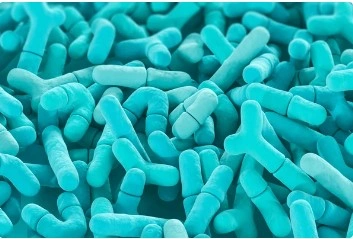
Chronically Low Bifidobacterium
While Bifidobacterium dominates the microbiome of infants, it is not uncommon to see Bifidobacterium less than 0.1% in the adult microbiome. Since Bifidobacterium has demonstrated anti-inflammatory properties and supports gut integrity and a healthy microbiome, and low Bifidobacterium has been associated with asthma, allergies, IBS, weight gain and more1,2, increasing Bifidobacterium abundance may have many health benefits.
So why do some people struggle with chronically low Bifidobacterium? To find that answer, we have to look at three main microbiome modulators: diet, genetics, and medications.
Diet3
The following is associated with lower Bifidobacterium:
- Alcohol
- Animal protein
- Fish
- Red wine
- Total fat
The following is associated with higher Bifidobacterium:
- Carbohydrates
- Fiber
- Fruit
- Plant protein
So the standard Western diet is not set up to support Bifidobacterium levels, which is probably a big reason why we see lower Bifidobacterium levels from North America and many parts of Europe.
Genetics
There are two genes that are well known to impact Bifidobacterium abundance (so far): lactase gene and fucosyltransferase 2 (FUT2).
The lactase gene encodes the enzyme, lactase, which is expressed in the small intestine to break down the milk sugar lactose. Research has shown that specific single nucleotide polymorphisms (SNPs) in the lactase gene are associated with higher levels of Bifidobacterium4. What this means is that different variants of the lactase gene (slightly different DNA sequences) that result in a less functional lactase enzyme are associated with higher levels of Bifidobacterium. If your lactase enzyme is not as functional, that means more lactose ends up in your large intestine (rather than being absorbed into your bloodstream in the small intestine) and lactose can feed Bifidobacterium. It is important to note that the higher Bifidobacterium was seen with the lactase mutation AND lactose consumption.
The FUT2 gene is a little more complicated. FUT2 is an enzyme that will essentially add our blood type antigen into mucus and other secretions. Our blood type antigen are primarily made up of different sugar rings, to put it very simplistically. Now, remember, your large intestine has a large layer of mucus that coats the service. So this FUT2 gene, if working as designed, will add these sugar rings to the mucus in your gut. These sugar rings can then be food for bacteria like Bifidobacterium. But if you have a certain mutation in the gene for FUT2, you will be what we call a non-secretor, and you will not put the sugar rings in your mucus. So non-secretor = less food for bacteria = lower Bifidobacterium5.
Medications
Bifidobacterium appears to be very sensitive to a variety of medications. Obviously, the first medication to think about is antibiotics. Patients who routinely (once a year or more) take antibiotics, struggle with Bifidobacterium. But also, many common medications can impact Bifidobacterium.
In the test tube, a study found medications like Aleve, Aspirin, Tylenol, Hydrocodone, Lisinopril, Metformin, Metoprolol, or Glipizide to decrease Bifidobacterium6. In particular, Aleve, Aspirin, and Tylenol killed Bifidobacterium6. These are fairly commonly and frequently used medications that may have a lasting negative impact on the microbiome.
Increasing Bifidobacterium
So obviously, you can clean up your diet and avoid certain medications, but there is nothing you can do about your genetics. So some individuals, despite their best efforts, will always have low Bifidobacterium. Many individuals struggle to increase Bifidobacterium above 0.5% even when using prebiotics.
Prebiotics like arabinogalactan7, resistant starch7, lactulose8, and human milk oligosaccharides9 can increase Bifidobacterium. But manage your expectations. Bifidobacterium will have to compete with many other microbes for utilization of these prebiotics. If it is already at a very low relative abundance, it will not be in a strong position to compete. So results are typically modest. You can increase results by increasing the dose, but do so gradually to reduce side effects. I would also recommend adding polyphenols to the prebiotics. Polyphenols and flavonoids are an overlooked microbiome modulator. Like with prebiotics, effects will be dose dependent, so the higher the better. I recommend sourcing the polyphenols from the red, blue, and purple spectrum. So think blueberry powder and pomegranate extract.
Individuals who are struggling to increase Bifidobacterium may consider supplementing with a good quality, broad spectrum, high dose Bifidobacterium probiotic to get the benefits of Bifidobacterium. The problem with probiotics can be quality and dose. It is very common to see a Bifidobacterium probiotic of 10 billion CFUs daily not to change abundance on stool testing. You may see better benefits with 100 billion CFUs+. However, the quality may be the problem. Many probiotics on the market do not actually contain what the label says (CFU is actually less). If supplements are not stored and shipped correctly, the probiotic may lose viability (bacteria die) and there is also the problem of surviving the stomach acid, which not all probiotics do. To check if your probiotic is good quality, see if they have third party testing verifying the accuracy and viability of their probiotic. Even if the probiotic is dead when it reaches your large intestine, it can still interact with your gut cells and immune system and have positive health benefits. But most probiotics, whether dead or alive, do not colonize the large intestine. Probiotic supplements tend to be visitors, lasting for about 2 weeks before leaving the ecosystem, though there is a lot of debate about this in the research. So Bifidobacterium supplementation would need to be ongoing. Please note that even dead probiotics should show up on 16S rRNA sequencing.
Please remember to talk to your doctor before making any changes to your healthcare regimen.
As you delve into the valuable insights shared by Dr Carly Polland on increasing Bifidobacteria, we are excited to share a special offer from our affiliate partner, Layer Origin. Their flagship HMO prebiotics are highly effective at boosting Bifidobacteria levels, making them an excellent addition to your supplement regimen. Enjoy a 10% discount on all Layer Origin products with the code BIOMESIGHT10. Visit this link to take advantage of this offer.
References
1. Arboleya S, Watkins C, Stanton C, Ross RP. Gut Bifidobacteria Populations in Human Health and Aging. Front Microbiol. 2016;7:1204. doi:10.3389/fmicb.2016.01204
2. Derrien M, Turroni F, Ventura M, van Sinderen D. Insights into endogenous Bifidobacterium species in the human gut microbiota during adulthood. Trends in Microbiology. 2022;30(10):940-947. doi:10.1016/j.tim.2022.04.004
3. Bolte LA, Vich Vila A, Imhann F, Collij V, Gacesa R, Peters V, Wijmenga C, Kurilshikov A, Campmans-Kuijpers MJE, Fu J, Dijkstra G, Zhernakova A, Weersma RK. Long-term dietary patterns are associated with pro-inflammatory and anti-inflammatory features of the gut microbiome. Gut. 2021 Jul;70(7):1287-1298. doi: 10.1136/gutjnl-2020-322670. Epub 2021 Apr 2. PMID: 33811041; PMCID: PMC8223641.
4. Kurilshikov A, Medina-Gomez C, Bacigalupe R, Radjabzadeh D, Wang J, Demirkan A, Le Roy CI, Raygoza Garay JA, Finnicum CT, Liu X, Zhernakova DV, Bonder MJ, Hansen TH, Frost F, Rühlemann MC, Turpin W, Moon JY, Kim HN, Lüll K, Barkan E, Shah SA, Fornage M, Szopinska-Tokov J, Wallen ZD, Borisevich D, Agreus L, Andreasson A, Bang C, Bedrani L, Bell JT, Bisgaard H, Boehnke M, Boomsma DI, Burk RD, Claringbould A, Croitoru K, Davies GE, van Duijn CM, Duijts L, Falony G, Fu J, van der Graaf A, Hansen T, Homuth G, Hughes DA, Ijzerman RG, Jackson MA, Jaddoe VWV, Joossens M, Jørgensen T, Kszthelyi D, Knight R, Laakso M, Laudes M, Launer LJ, Lieb W, Lusis AJ, Masclee AAM, Moll HA, Mujagic Z, Qibin Q, Rothschild D, Shin H, Sørensen SJ, Steves CJ, Thorsen J, Timpson NJ, Tito RY, Vieira-Silva S, Völker U, Völzke H, Võsa U, Wade KH, Walter S, Watanabe K, Weiss S, Weiss FU, Weissbrod O, Westra HJ, Willemsen G, Payami H, Jonkers DMAE, Arias Vasquez A, de Geus EJC, Meyer KA, Stokholm J, Segal E, Org E, Wijmenga C, Kim HL, Kaplan RC, Spector TD, Uitterlinden AG, Rivadeneira F, Franke A, Lerch MM, Franke L, Sanna S, D'Amato M, Pedersen O, Paterson AD, Kraaij R, Raes J, Zhernakova A. Large-scale association analyses identify host factors influencing human gut microbiome composition. Nat Genet. 2021 Feb;53(2):156-165. doi: 10.1038/s41588-020-00763-1. Epub 2021 Jan 18. PMID: 33462485; PMCID: PMC8515199.
5. Wacklin P, Mäkivuokko H, Alakulppi N, Nikkilä J, Tenkanen H, Räbinä J, Partanen J, Aranko K, Mättö J. Secretor genotype (FUT2 gene) is strongly associated with the composition of Bifidobacteria in the human intestine. PLoS One. 2011;6(5):e20113. doi: 10.1371/journal.pone.0020113. Epub 2011 May 19. PMID: 21625510; PMCID: PMC3098274.
6. Obanla TO, Hayek SA, Gyawali R, Ibrahim SA. Interaction Between Bifidobacterium and Medical Drugs. In: Uzochukwu GA, Schimmel K, Kabadi V, Chang SY, Pinder T, Ibrahim SA, eds. Proceedings of the 2013 National Conference on Advances in Environmental Science and Technology. Springer International Publishing; 2016:171-178. doi:10.1007/978-3-319-19923-8_17
7. Derrien M, Turroni F, Ventura M, van Sinderen D. Insights into endogenous Bifidobacterium species in the human gut microbiota during adulthood. Trends in Microbiology. 2022;30(10):940-947. doi:10.1016/j.tim.2022.04.004
8. Karakan T, Tuohy KM, Janssen-van Solingen G. Low-Dose Lactulose as a Prebiotic for Improved Gut Health and Enhanced Mineral Absorption. Frontiers in Nutrition. 2021;8. Accessed February 20, 2023
9. Breast milk-derived human milk oligosaccharides promote Bifidobacterium interactions within a single ecosystem | The ISME Journal. Accessed February 20, 2023. https://www.nature.com/articles/s41396-019-0553-2
Categories: bifidobacteria HMO Prebiotics Tags: bifidobacteria HMO prebiotics
